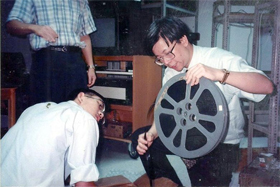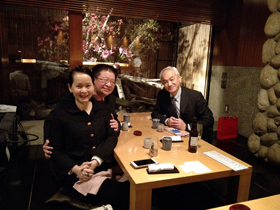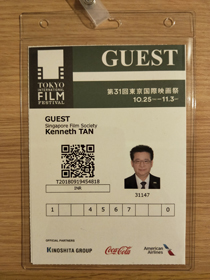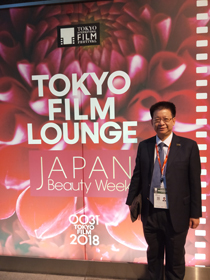

Featured Article of the Month
Falling in Love with Japan: Movies, Music, Magical Memories
By Mr Kenneth Tan
|
I have been to Japan twenty times. It is the country I have visited most, anywhere in the world. Every single trip I have made there has been by personal choice. I love Japan. And I’d love to share, with JCC’s readers, exactly why.
Movies are my passion, my profession, my life. I’ve been watching films from all over the world since I was a child. In my early teens, I got to know the work of Akira Kurosawa. Even as an untrained boy, I marveled at the sweep and spectacle of his epic productions; at the depth and vividness of his characters and stories. As a young officer in 1983, newly recruited into the Singapore Film Society, I worked on my very first Japanese Film Festival (JFF) in Singapore. The film in that year’s festival program which I remember most strikingly is Yasujiro Ozu’s TOKYO STORY. I will never forget its depictions of aged parents connecting with their adult children. Soon after that festival, in 1984, the J-Pop group, SHOHJO-TAI, was formed. I bought every magazine, poster, album, single, trading card, and any type of memorabilia I could find, as long as it was related to the three members, Miho Aida, Reiko Yasuhara, and Chiiko Ichikawa (later replaced by Tomoko Hikita). SHOHJO-TAI was one of the longest-performing groups in modern J-Pop history, disbanding only in 1989, five years after their formation. I even attended their live concerts, twice! |
| 1986 saw a new friendship formed, with the young Motohiko Kato who was newly-posted to the Embassy of Japan in Singapore as Second Secretary. That year, Kato-san and I organised not one but two Japanese Film Festivals, including a complete retrospective of Akira Kurosawa’s works up to KAGEMUSHA. (Kato-san eventually became Japan’s Ambassador to Brunei.) My work on Japanese Film Festivals has continued till today! The Singapore Film Society, which I lead as Chairman, co-organises JFF with the Japan Creative Centre and The Japan Foundation. We opened our Japanese Film Festival in Singapore this year with Shinichiro Ueda’s cult feature debut, ONE CUT OF THE DEAD, with Ueda-san and a whole delegation of Japanese filmmakers and actors in attendance! JFF holds a very special place in the hearts of all my colleagues and myself. It is a truly collaborative project – as partners and friends, we mutually select and curate the films, plan the strategies and budgets, manage the logistics, market the screenings and masterclasses…..and, most important of all, enjoy and enrich ourselves so much as we immerse ourselves in each other’s culture and friendship. |  Working on a film reel in the 1990s / © Singapore Film Society  Japanese Film Festival 2019 / © JFF |
|
JFF 2020 will open on February 20th, 2020. Mark that date in your calendars!
My love for Japan is not just a long-distance affair. When I was offered the chance, in 1991, to go on a month-long staff attachment in Tokyo, I was thrilled beyond words. During my four weeks’ stay there, I bought over a hundred J-Pop CDs, including albums and compilations by CoCo, Yoko Minamino, Tomomi Nishimura, Wink, Ribbon, Cotton, and many other idols and groups I was faithfully following after the retirement of Shohjo-Tai. One of my most magical Japanese memories came about in the following manner. My flight back to Singapore was such that I would have to leave my Tokyo hotel at 7.00am. As the hotel’s main café opened only at 7.00am, I knew I would not be able to have breakfast there on my last day, so, on the previous day, I informed the lady supervisor who had started recognizing me within my first week there, that that would be my last breakfast and I thanked her for serving me so well for almost a month. She scurried into the kitchen for a while, and then came back to me and told me to come downstairs the next morning at 6.30am. I was really touched, thinking that she must have made arrangements for the kitchen to start early for me. |
|
The next morning, I was down in the lobby before 6.30am. The café shutters were closed. No one was around. 6.30am. 6.35am. Still nothing. I was beginning to think that I must have misunderstood the lady. Then, at 6.39am, she came rushing in through the hotel’s front door, panting, and profusely apologizing. She then held something out to me, with both hands, and said, “choshoku-no bento desu, present-o, dozou” (“here is a breakfast bento set, as a present, please”).
I was so, so, so touched. I cannot describe in words how I felt. It was obvious that the bento was something she had bought from outside – it was not the hotel’s food. I clasped her hand in mine, and thanked her in as heartfelt a manner as my rudimentary Japanese would allow. When I got back to Singapore, I wrote a commendation letter about her to the General Manager of the hotel. And, later that year, Nakajima-san, that lady, came to Singapore with her sister and we had a wonderful dinner together. |  With Kaoru Suzuki (now President and Representative Director of J.D. Power Asia Pacific) who helped to translate the commendation letter. |
|
When people ask me why my love for Japan is so deep, I often tell them this story. Even my Japanese friends say, “even by Japanese standards, this is absolutely amazing”. Nakajima-san had no reason at all to do that for me. She would never see me again, in all likelihood. But she did it. She did something so simple, yet so moving, that it permanently etched a compartment of love and affection in my heart for not just Japanese culture and society, but the country as a whole.
And so I’ve chosen to go back to Japan, again and again. I was honoured and delighted to be able to represent my organisation and my industry at The Japan Foundation Asia Center’s Programmers’ Conference during the Tokyo International Film Festival in 2018, where I presented a paper on “Catalysing, Celebrating, and Creating Consumption and Collaboration in Cinema”. |   At Tokyo International Film Festival in 2018. |
| One other piece of trivia, for JCC’s readers. In 2006, after many, many experiences of trial and error and a whole lot of walking, I finally mastered Shinjuku station. If you’ve ever been there, you’ll know that it has numerous lines and levels. It is reputed to be the busiest train station in the world. Well, I gained this insight in 2006: the only part of Shinjuku station that gives you access to all exits and all other lines, is the train platform itself. You must stay on the platform, and not get distracted or redirected to a different exit from the one you intend to use. That is the only way to ensure you do not get lost. Try it when you’re there. It works! |
About the Author
|
Mr Kenneth Tan is Chairman of the Singapore Film Society, the longest-established organisation in Singapore promoting appreciation of cinema as a medium of both art and entertainment. With over thirty years’ experience in the media industry, Kenneth has held top management positions in Mediacorp, Golden Village, and the Info-communications Media Development Authority. He is a frequent speaker at international conferences, having done keynote presentations and panel speeches in 14 countries on three continents. He graduated with First Class Honours in Business Administration from the National University of Singapore, and was Chairman of the Promote Mandarin Council, responsible for Singapore’s national Speak Mandarin Campaign. * All photos used in this article are provided by the author unless otherwise stated / © Mr Kenneth Tan |
|
Japan Creative Centre 4 Nassim Road, Singapore 258372 +65 6737 0434 / jcc@sn.mofa.go.jp http://www.sg.emb-japan.go.jp/JCC Nearest parking at Orchard Hotel & Delphi Orchard |
 |